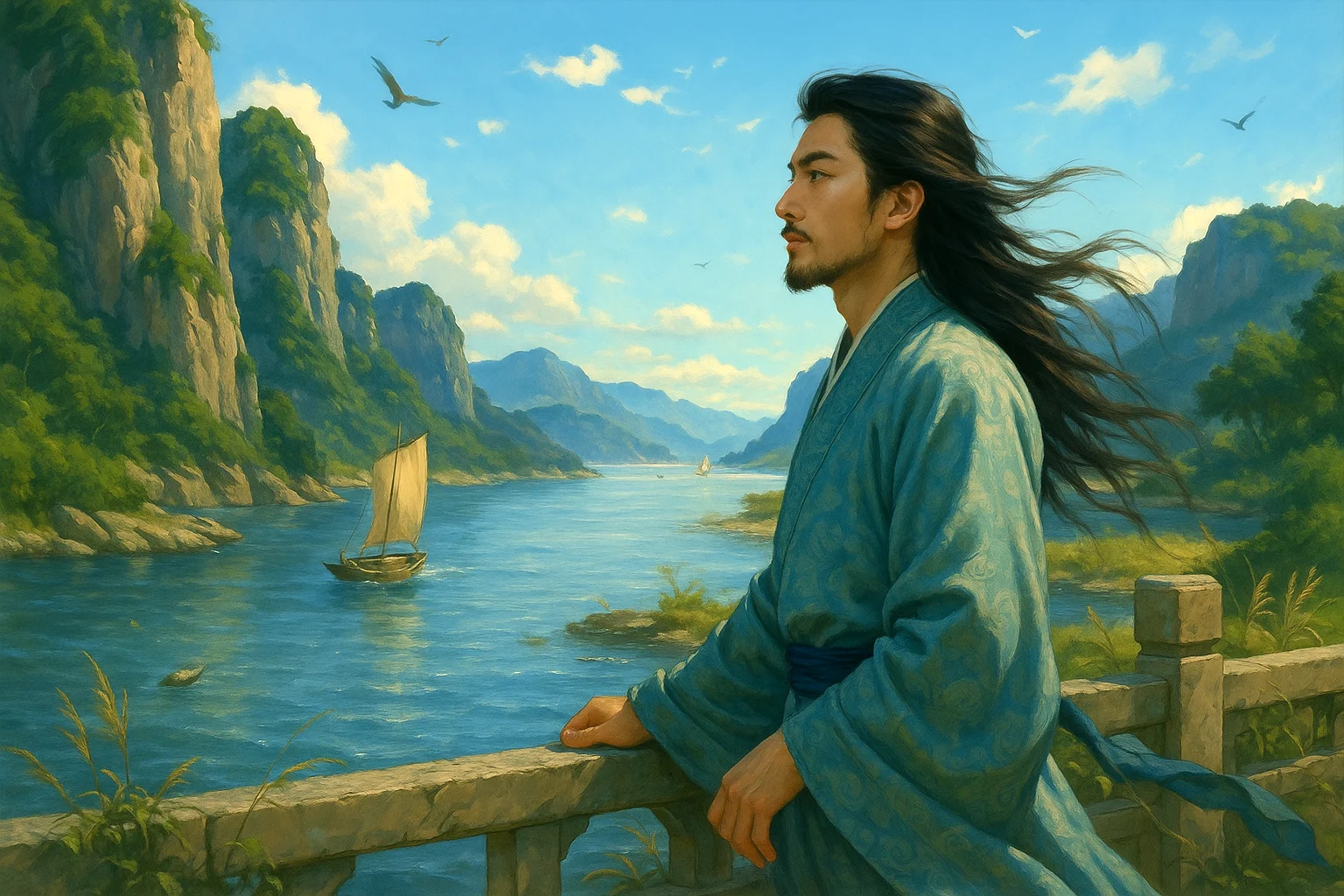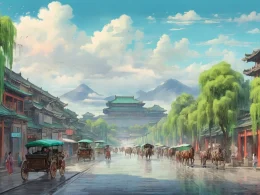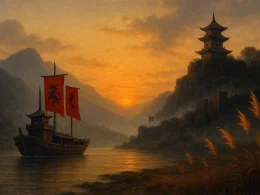In rushed rouge, they flock to see,
Through bramble gates, giggling three by three.
Crimson skirts tear as they push—what glee!
Young and old to harvest rites proceed,
Crows whirl where village gods they plead.
At dusk, a drunk old man blocks the road—take heed!
Original Poem
「浣溪沙 · 旋抹红妆看使君」
苏轼
旋抹红妆看使君,三三五五棘篱门。相排踏破蒨罗裙。
老幼扶携收麦社,乌鸢翔舞赛神村。道逢醉叟卧黄昏。
Interpretation
Composed in 1078 during Su Shi's governorship of Xuzhou, this cí forms part of a quintet written after successful rain prayers at Stone Pond. Following a devastating drought, the poems document village jubilation with ethnographic precision—marking a watershed in Sòng cí's shift from courtly romance to social realism. The second installment captures three vignettes of rural ecstasy, revealing Su Shi's revolutionary ability to find lyricism in everyday folkways.
Upper Stanza: "旋抹红妆看使君,三三五五棘篱门。相排踏破蒨罗裙。"
Xuán mǒ hóngzhuāng kàn shǐjūn, sānsānwǔwǔ jílí mén. Xiāng pái tàpò qiàn luó qūn.
Smearing rouge in haste to see their governor— / Clustered at bramble gates in chattering groups, / They jostle till embroidered skirts tear underfoot.
Here, rural women's frenzied grooming ("smearing rouge in haste") becomes political theater—their eagerness reflecting Su Shi's unprecedented rapport with commoners. The "bramble gates" (棘篱门) authenticate village poverty, while the shredded "embroidered skirts" (蒨罗裙)—likely their finest attire—symbolize both celebratory abandon and the fragile beauty of hardscrabble lives. Su Shi's camera-eye moves from intimate makeup ritual to chaotic crowd shot with cinematic fluency.
Lower Stanza: "老幼扶携收麦社,乌鸢翔舞赛神村。道逢醉叟卧黄昏。"
Lǎo yòu fúxié shōu mài shè, wū yuān xiángwǔ sài shén cūn. Dào féng zuì sǒu wò huánghūn.
Young steadying old at wheat-thanking rites— / Kites wheel above the deity-parading lanes, / Till dusk reveals a grandpa drunk in roadside weeds.
The stanza unfolds as a triptych: first, intergenerational solidarity ("young steadying old") at harvest rituals; next, scavenger kites mistaking religious processions for carrion feasts—a darkly humorous nod to nature's indifference; finally, the drunken elder embodying communal catharsis. The "kites" (乌鸢) perform double duty as ecological fact and spiritual metaphor—their dance mirroring human joy yet rooted in primal hunger.
Holistic Appreciation
This lyric poem employs a "cinematic" lens to craft a vivid rural tableau. The first stanza captures a "doorway scene," while the second pans to "field vistas and close-ups," depicting village women, elders, children, birds, and a drunken elder—each detail coalescing into a jubilant celebration of long-awaited rain. Though Su Shi refers to himself as the "commissioner," he does not observe from a lofty perch but immerses himself as a participant and chronicler, infusing the poem with humanistic warmth and shared joy.
The language is unadorned yet vibrant, blending realism with poetic romance. More than a picturesque pastoral, it stands as a "rural documentary" rich with social significance.
Artistic Merits
- Documentary Realism, Folk Intimacy
Breaking from conventional lyricism’s "flowery decadence," Su Shi adopts a realist brush to portray farming life and folk customs. The poem thrums with the unvarnished joy and bustle of rural existence, revitalizing the lyric form with his signature populist ethos. - Dynamic Framing, Vivid Imagery
Lines like "hastily rouging cheeks," "trampling silk skirts," and "a drunk elder reclining at dusk" pulse with kinetic energy, unfolding like sequenced film shots—visually striking and narratively rhythmic. - Scene-Emotion Fusion, Poetic Density
"Gazing at the commissioner" doubles as both a ceremonial observance and spontaneous village curiosity; "kites wheeling in flight" mirrors both literal spectacle and divine auspice. Nature and humanity, reality and imagination converge, thickening the poem’s lyrical atmosphere. - Plainspoken Depth
The diction is earthy and succinct, yet brimming with charm. Unpolished and unpretentious, it reveals Su Shi’s profound empathy and refined aesthetic, transmuting rustic vitality into enduring artistry.
Insights
This poem is not merely a rustic idyll but a testament to literati engagement with common joy. It reminds us that literature’s truest warmth lies not in palace towers but in furrowed fields; not in lavish rhetoric but in humble lanes. By documenting the elation of "village girls" and "tipsy elders" as the "commissioner," Su Shi embodies his magnanimity and devotion to people’s welfare.
Moreover, it expands the boundaries of Song lyric poetry, proving its capacity to chronicle society and reality—a dual triumph of historical value and aesthetic power.
About the Poet

Su Shi (苏轼, 1037 - 1101), a native of Meishan in Sichuan, was a polymath of the Northern Song literary world. His prose was expansive and unrestrained, his poetry fresh and vigorous, and his ci poetry pioneered the bold and unconstrained style. In calligraphy, he created the "Su Style," and in painting, he championed "spiritual resonance," earning him a place among the "Four Masters of the Song." Despite repeated political persecutions—most notably the "Poetry Case of the Black Terrace"—his exile to Huangzhou, Huizhou, and Danzhou yielded timeless masterpieces. Lu You praised him as "the literary patriarch of an era."












